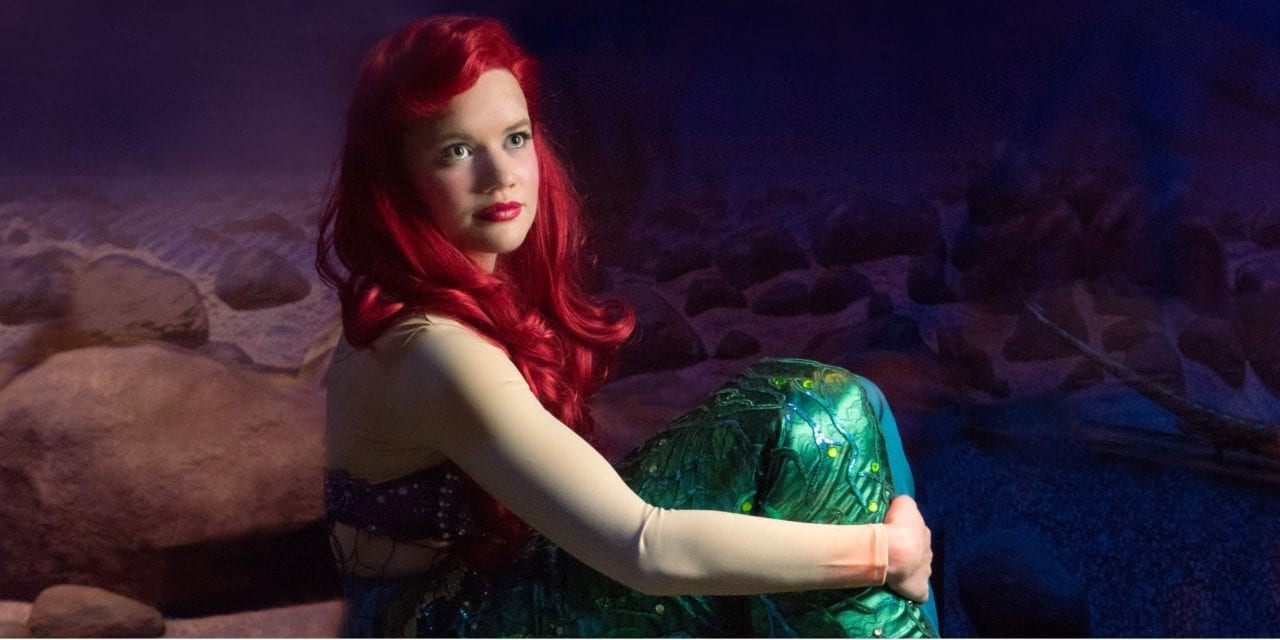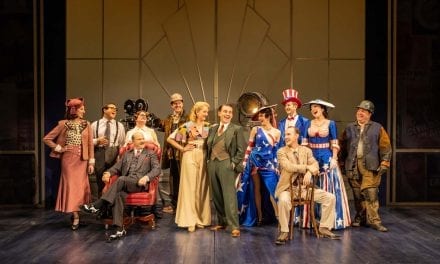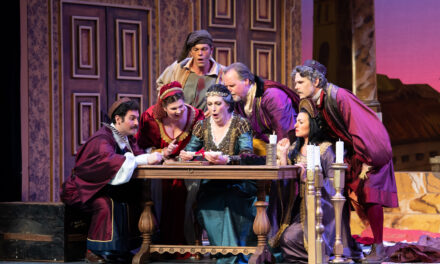OREM — In the depths of a dreary, brown Utah winter, there’s a bright spot on stage: The Little Mermaid at Hale Center Theater Orem. This bright and joyous adaptation (with music by Alan Menken and lyrics by Howard Ashman and Glenn Slater) is a sunny escape from the cold for theatre goers of all ages.

Show closes April 14, 2018.
Generally speaking, the performances of The Little Mermaid were best when the actors ignored the film version of their characters. Lauren Pope is a sweet Ariel, and her renditions of “Part of Your World” and “Beyond My Wildest Dreams” were full of curiosity and wonder. When Ariel loses her voice in the second act, Pope didn’t lose any magic in her performance, and I enjoyed watching her struggles using her new legs in “Positoovity” or her infatuation in “One Step Closer.”
As Prince Eric, David Matthew Smith‘s performance was bland and unvarying. Smith delivered most of his lines with the same tone and a low level of emotion behind them, which made it hard to believe there was a romantic relationship developing between Eric and Ariel. On the other hand, Doug Wright‘s script does not give Smith much to work with; the character is basically a male ingénue who waits around for his romantic interest to show up. Still, Smith has a lovely singing voice, and his contributions to the “If Only” quartet, “Her Voice,” and “One Step Closer” were musical strengths of the show.

Lauren Pope as Ariel. Photo by Suzy Oliveria.
Although the leads were nice, where The Little Mermaid most impresses is in the supporting cast, especially the female ensemble, who consistently wowed. When these women played Ariel’s sisters, each actress gave her character a unique personality and lots of pizzazz. On land, they played servants, seagulls, and princesses and brightened up every scene they appeared in. One pleasant surprise in the supporting cast was Nate Waite as Chef Louis. The characters’ scenes and the song “Les Poissons” are completely unnecessary and only included because they are favorite moments in the movie. But Waite made “Les Poissons” hilarious as he goofily chased Alec Powell (playing the crab Sebastian) around the stage. Powell was an enjoyable Sebastian, and he was successful in showing the character’s sympathy for Ariel, even when Sebastian thought she should just obey her father, King Triton.
Dave Burton played King Triton authoritatively, and his booming voice and imposing physique gave gravitas to the production. But his ability to command could give way to tenderness as King Triton worried about his missing daughter. However, the best performance of the evening was from Mack in the role of Ursula. Mack was successful in making the role completely her own, and her portrayal of an almost seductive Ursula was a rousing success. Ursula’s confident bearing and silvery speaking voice made it clear why Ariel could be enticed to make a deal with her.
Director Lisa Hall Hagen was the captain of this production who was responsible for coaxing so many pleasing performances out of the cast. While the production started out just fine, the song “She’s in Love” (with cutesy choreography from Ashley Gardner Carlson) gave the show a much-needed shot of energy that propelled it through the iconic “Under the Sea” and towards intermission. Hagen also avoided the common pitfall in The Little Mermaid of letting the second act become stagnant as the action moves to the much more staid environment on dry land. Hagen’s innovative staging of “Beyond My Wildest Dreams,” and the sublimely beautiful “Kiss the Girl” made the show worth the price of admission. Finally, I appreciated Hagen’s decision to stage “Poor Unfortunate Souls” in a way that highlighted the power differences between Ursula and Ariel. This contrast highlighted important differences in the characters and added dramatic tension to the scene.
The costumes designed by Cole McClure are one component of the show that is sure to wow many audience members. The costumes for the human characters were faithful to an 18th century setting, with brocade coats, long dresses, and powdered wigs for many men. What surprised me, though were that the undersea costumes used many of the same fashion motifs to create a unified visual style, instead of making the undersea world completely foreign to the “land folk.” Some of the costumes are unlike anything I have ever seen on stage before, such as King Triton’s merman armor. The choice to make many of the fish represented by headpieces worn by actors was also an astute one because it allowed performers to move and express emotion freely. On the other hand, there were a few costumes (like a frog in “Kiss the Girl,” the attendants to King Triton dressed in brown, or the women’s costumes at the singing contest) that seemed unfinished. Still, the costumes were generally a gorgeous asset to the play, and the fabulous lighting design by Cody Swenson showcased them beautifully.
The Little Mermaid is an exceptionally difficult show to stage. The complex technical action, the frequent dance numbers, and the problem of a protagonist who says very little in the second act cause many productions stumble. But the director, designers, and cast make this show look deceptively easy. As a result, audience members can kick back and enjoy their brief vacation to the sun and sea of this rollicking Disney favorite.
Donate to Utah Theatre Bloggers Association today and help support theatre criticism in Utah. Our staff work hard to be an independent voice in our arts community. Currently, our goal is to pay our reviewers and editors. UTBA is a non-profit organization, and your donation is fully tax deductible.





